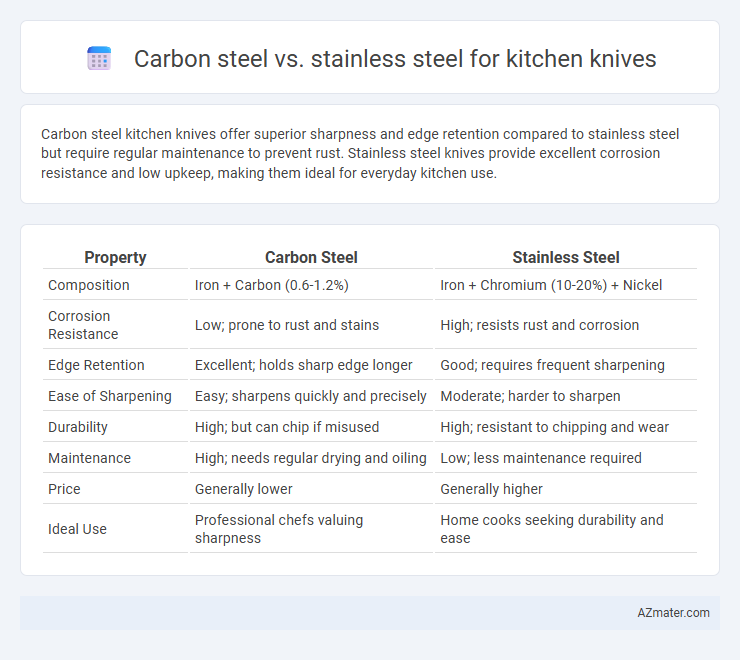Carbon steel kitchen knives offer superior sharpness and edge retention compared to stainless steel but require regular maintenance to prevent rust. Stainless steel knives provide excellent corrosion resistance and low upkeep, making them ideal for everyday kitchen use.
Table of Comparison
| Property | Carbon Steel | Stainless Steel |
|---|---|---|
| Composition | Iron + Carbon (0.6-1.2%) | Iron + Chromium (10-20%) + Nickel |
| Corrosion Resistance | Low; prone to rust and stains | High; resists rust and corrosion |
| Edge Retention | Excellent; holds sharp edge longer | Good; requires frequent sharpening |
| Ease of Sharpening | Easy; sharpens quickly and precisely | Moderate; harder to sharpen |
| Durability | High; but can chip if misused | High; resistant to chipping and wear |
| Maintenance | High; needs regular drying and oiling | Low; less maintenance required |
| Price | Generally lower | Generally higher |
| Ideal Use | Professional chefs valuing sharpness | Home cooks seeking durability and ease |
Introduction: Carbon Steel vs Stainless Steel Kitchen Knives
Carbon steel knives offer exceptional sharpness and edge retention, making them a preferred choice for professional chefs who require precise cutting performance. Stainless steel knives excel in corrosion resistance and low maintenance, ideal for home kitchens where durability and ease of cleaning are priorities. Choosing between carbon steel and stainless steel hinges on balancing sharpness with rust resistance tailored to specific culinary needs.
Key Material Differences
Carbon steel kitchen knives offer superior sharpness and edge retention due to higher carbon content, making them ideal for precision cutting but prone to rust and discoloration if not properly maintained. Stainless steel knives contain chromium, which provides excellent corrosion resistance and low maintenance but generally sacrifices some sharpness and edge retention compared to carbon steel. The choice between carbon steel and stainless steel depends on balancing the need for durability, ease of care, and cutting performance in kitchen applications.
Sharpness and Edge Retention
Carbon steel kitchen knives offer superior sharpness and can achieve a finer, more precise edge compared to stainless steel, making them ideal for tasks requiring extreme precision. Their edge retention is excellent due to higher hardness levels, allowing them to stay sharper longer but they require more maintenance to prevent corrosion. Stainless steel knives typically have lower hardness and thus slightly less sharpness and edge retention but offer better rust resistance and easier upkeep for everyday kitchen use.
Corrosion Resistance and Maintenance
Stainless steel kitchen knives offer superior corrosion resistance due to their chromium content, which forms a passive oxide layer that prevents rust and staining. Carbon steel knives, while easier to sharpen and capable of retaining a sharper edge, require careful maintenance including regular drying and oiling to prevent rust and corrosion. For optimal longevity and low maintenance, stainless steel is ideal in humid or wet kitchen environments, whereas carbon steel suits users willing to perform consistent upkeep.
Ease of Sharpening
Carbon steel knives are generally easier to sharpen due to their softer composition and ability to achieve a finer edge with less effort, making them preferred by chefs who frequently maintain their blades. Stainless steel knives, while corrosion-resistant, often require more specialized sharpening tools and techniques because of their harder, more wear-resistant alloys. The ease of sharpening directly influences performance and longevity, with carbon steel offering faster edge restoration but needing more care to prevent rust.
Durability and Longevity
Carbon steel kitchen knives offer superior edge retention and can be sharpened to a razor-sharp edge, making them highly durable for everyday use. Stainless steel knives resist rust and corrosion due to their chromium content, providing excellent longevity in moist kitchen environments. However, carbon steel requires regular maintenance to prevent oxidation, while stainless steel demands less upkeep, ensuring consistent performance over time.
Performance in Kitchen Tasks
Carbon steel knives offer superior sharpness and edge retention, making them ideal for precision slicing and detailed kitchen tasks. Stainless steel knives excel in resistance to rust and corrosion, ensuring durability and low maintenance in wet kitchen environments. Performance-wise, carbon steel provides exceptional cutting efficiency, while stainless steel balances functionality with ease of care.
Price and Value Comparison
Carbon steel kitchen knives generally offer a lower upfront price while delivering superior sharpness and ease of sharpening compared to stainless steel options. Stainless steel knives tend to cost more due to their corrosion resistance and low maintenance, but this durability can provide better long-term value for users seeking minimal upkeep. Choosing between them depends on balancing initial cost savings against performance needs and maintenance preferences in the kitchen.
Ideal Uses for Each Steel Type
Carbon steel kitchen knives excel in precision cutting tasks such as slicing and dicing vegetables, meats, and fish due to their superior sharpness and edge retention. Stainless steel knives are ideal for environments requiring high corrosion resistance, making them perfect for cutting acidic foods and frequent dishwasher use. Chefs often prefer carbon steel for detailed culinary work, while stainless steel suits general-purpose kitchen tasks demanding durability and low maintenance.
Choosing the Right Knife for Your Needs
Carbon steel kitchen knives offer superior sharpness and edge retention, making them ideal for precision cutting tasks, but they require regular maintenance to prevent rust and corrosion. Stainless steel knives provide excellent resistance to staining and rust, requiring less upkeep and offering durability suitable for everyday kitchen use. Choosing the right knife depends on balancing the need for sharpness and ease of maintenance with the specific culinary tasks and frequency of use.

Infographic: Carbon steel vs Stainless steel for Kitchen knife
 azmater.com
azmater.com